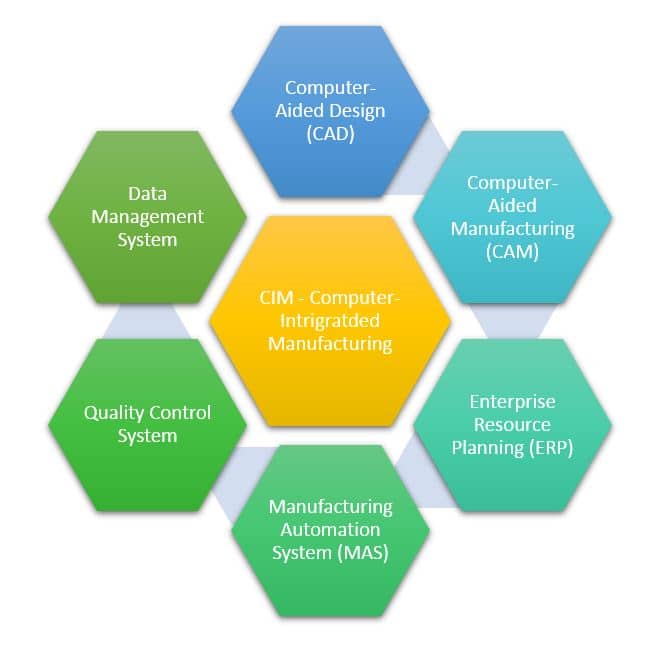Streamline Your Manufacturing Process with Computer-Integrated Manufacturing (CIM)
Computer-integrated manufacturing (CIM) refers to the integration of computer technology and software into the manufacturing process. The goal of CIM is to optimize and streamline the manufacturing process by automating repetitive tasks, reducing manual intervention, and providing real-time data and feedback. By integrating computer systems and technologies such as computer-aided design (CAD), computer-aided manufacturing (CAM), and enterprise resource planning (ERP), CIM provides a seamless flow of information and processes throughout the entire manufacturing cycle. This leads to improved efficiency, accuracy, and quality, as well as increased production speed and better overall control and management of the manufacturing process.
The benefits of Computer-Integrated Manufacturing
Computer-Integrated Manufacturing (CIM) offers numerous benefits to organizations in the manufacturing industry, including:
- Increased Efficiency: CIM automates repetitive tasks, reduces manual intervention, and provides real-time data and feedback. Leading to increased efficiency and faster production times.
- Improved Quality: By integrating computer systems and technologies, CIM provides a seamless flow of information and processes throughout the entire manufacturing cycle. Then the results in improved product quality and reduced waste and errors.
- Better Control and Management: CIM provides real-time visibility into the manufacturing process, allowing organizations to monitor progress and make informed decisions. Then this will be leading to better control and management of the manufacturing process.
- Cost Savings: By improving efficiency, reducing waste and errors, and increasing production speed, CIM can help organizations save costs and increase profitability.
- Improved Customer Satisfaction: By providing high-quality products that meet customer expectations, CIM can improve customer satisfaction and build brand loyalty.
- Enhanced Flexibility: CIM allows organizations to quickly respond to changes in demand and market conditions, leading to enhanced flexibility and competitiveness.
- Data-Driven Insights: CIM provides valuable data and insights that can help organizations optimize their operations and make informed decisions.
Overall, the benefits of CIM can help organizations in the manufacturing industry to remain competitive, improve their bottom line, and provide high-quality products and services to their customers.
The Different Components of a CIM System
A Computer-Integrated Manufacturing (CIM) system typically consists of the following components:
- Computer-Aided Design (CAD)
- Computer-Aided Manufacturing (CAM)
- Enterprise Resource Planning (ERP)
- Manufacturing Automation System (MAS)
- Quality Control System
- Data Management System

By integrating these components, a CIM system provides a seamless flow of information and processes throughout the entire manufacturing cycle.
The Importance of Real-Time Data and Feedback in the CIM Process.
Real-time data and feedback are essential for the Computer-Integrated Manufacturing (CIM) process. They provide visibility into the performance of the manufacturing process, allowing organizations to identify bottlenecks and optimize the process for maximum efficiency. Real-time data is used to monitor production schedules and track inventory levels. The Real-Time feedback ensures products are being produced to the required specifications. This leads to improved efficiency, accuracy, and quality, as well as cost savings and increased competitiveness. The ability to collect and analyze data in real-time provides organizations with the control they need. That will help to optimize and improve the manufacturing process.
Computer-integrated manufacturing software
Manufacturing organizations use computer-integrated manufacturing (CIM) software to streamline and automate processes from design to production. This software integrates various computer systems and technologies. Which are computer-aided design (CAD), computer-aided manufacturing (CAM), and enterprise resource planning (ERP). Those provide a seamless flow of information and processes throughout the entire manufacturing cycle.
CIM software improves manufacturing efficiency and accuracy by reducing manual intervention and automating repetitive tasks. It provides real-time data and feedback. This leads to improved product quality, faster production, reduced waste and errors, and better control and management. CIM also offers valuable data and insights for informed decision-making and operation optimization.
The Role of CIM Software in Automating Repetitive Tasks and Reducing Manual Intervention.
The role of Computer-Integrated Manufacturing (CIM) software is to automate repetitive tasks and reduce manual intervention in the manufacturing process. CIM software is designed to streamline and optimize the entire manufacturing cycle, from product design to production and quality control.
By automating repetitive tasks, CIM software reduces the risk of human error and increases accuracy, leading to improved quality and reduced waste. For example, CIM software can automate tasks such as;
- Product design
- Production scheduling
- Inventory management
CIM software can also reduce manual intervention in the production process by controlling and automating the production machinery and equipment. This reduces the need for manual labor and increases production speed, leading to cost savings and improved competitiveness.
In addition, CIM software provides real-time data and feedback, allowing organizations to monitor the production process and make informed decisions. This leads to better control and management of the manufacturing process, reducing the risk of unexpected disruptions and improving efficiency.
Overall, the role of CIM software is to automate repetitive tasks and reduce manual intervention, leading to improved efficiency, accuracy, and quality in the manufacturing process.
The Impact of CIM on the Workforce and the Need for Training and Upskilling.
The implementation of Computer-Integrated Manufacturing (CIM) can have a significant impact on the workforce in the manufacturing industry. CIM automation can replace manual labor and tasks with technology, leading to job loss for some workers and the need for new skills for others. Therefore, the implementation of CIM often requires training and upskilling for the workforce.
Workers need to be trained on the new technologies and systems being introduced, as well as on the new skills required for their roles. This can include training in areas such as computer skills, automation technologies, and data analysis. Organizations need to ensure that their workers have the necessary technical and soft skills to effectively operate and manage CIM systems, which may require upskilling and training programs. The impact of CIM on the workforce highlights the importance of training and upskilling to ensure workers are equipped with the skills they need to succeed in a rapidly evolving industry.



0 Comments